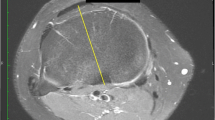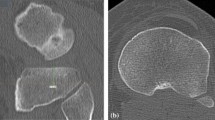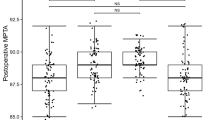Abstract
Purpose
The sagittal fibular axis serves as an intra-operative landmark during conventional total knee arthroplasty (TKA); however, only a few relevant anatomical studies have been published regarding its use as an extramedullary guide. Furthermore, the correlation between the coronal fibular and tibial mechanical axes in osteoarthritic knees has been only reported once. Here, the hypothesis of this study is that the fibula can be a reliable intra-operative landmark, in the sagittal and coronal planes, among patients with osteoarthritis who have undergone TKA.
Methods
Osteoarthritic knees (n = 62) after TKA were evaluated using three-dimensional image-matching software. The angles between the tibial mechanical axis and the fibular shaft axis were measured in the sagittal and coronal planes. Moreover, correlations between the angles and patient-specific factors were evaluated.
Results
The mean angle between the tibial mechanical and fibular shaft axes was 2.6° ± 2.3° for posterior inclination in the sagittal plane and 0.9° ± 2.0° for varus inclination in the coronal plane. The percentage of subjects with the fibular shaft axis within 2° of the tibial mechanical axis was 17.7 and 69.3 % in the sagittal and coronal planes, respectively. No patient-specific factors were correlated with the angle between the tibial mechanical and fibular shaft axes.
Conclusions
The angle between the tibial mechanical and fibular shaft axes differed among patients, independent of patient-specific factors, and did not appear to be a reliable intra-operative landmark. Surgeons should use values from individual pre-operative evaluations of the axis as reference for conventional TKA.
Level of evidence
Case series with no comparison group, Level IV.





Similar content being viewed by others
References
Akagi M, Oh M, Nonaka T, Tsujimoto H, Asano T, Hamanishi C (2004) An anteroposterior axis of the tibia for total knee arthroplasty. Clin Orthop Relat Res 420:213–219
Bai B, Baez J, Testa N, Kummer FJ (2000) Effect of posterior cut angle on tibial component loading. J Arthroplast 15(7):916–920
Bellemans J, Robijns F, Duerinckx J, Banks S, Vandenneucker H (2005) The influence of tibial slope on maximal flexion after total knee arthroplasty. Knee surg Sports Traumatol Arthros 13(3):193–196
Cashman JP, Carty FL, Synnott K, Kenny PJ (2011) Intramedullary versus extramedullary alignment of the tibial component in the triathlon knee. J Orthop Surg Res 6:44
Chinzei N, Ishida K, Matsumoto T, Kuroda Y, Kitagawa A, Kuroda R, Akisue T, Nishida K, Kurosaka M, Tsumura N (2013) Evaluation of patellofemoral joint in ADVANCE Medial-pivot total knee arthroplasty. Int Orthop 38(3):509–515
Dennis DA, Channer M, Susman MH, Stringer EA (1993) Intramedullary versus extramedullary tibial alignment systems in total knee arthroplasty. J Arthroplast 8(1):43–47
Han HS, Chang CB, Seong SC, Lee S, Lee MC (2008) Evaluation of anatomic references for tibial sagittal alignment in total knee arthroplasty. Knee Surg Sports Traumatol Arthrosc 16(4):373–377
Hernigou P, Deschamps G (2004) Posterior slope of the tibial implant and the outcome of unicompartmental knee arthroplasty. J Bone Joint Surg Am 86-A(3):506–511
Jojima H, Whiteside LA, Ogata K (2004) Effect of tibial slope or posterior cruciate ligament release on knee kinematics. Clin Orthop Relat Res 426:194–198
Kim D, Seong SC, Lee MC, Lee S (2012) Comparison of the tibiofemoral rotational alignment after mobile and fixed bearing total knee arthroplasty. Knee Surg Sports Traumatol Arthrosc 20(2):337–345
Kim YH, Park JW, Kim JS, Park SD (2014) The relationship between the survival of total knee arthroplasty and postoperative coronal, sagittal and rotational alignment of knee prosthesis. Int Orthop 38(2):379–385
Laskin RS (2003) Instrumentation pitfalls: you just can’t go on autopilot! J Arthroplasty 18(3 Suppl 1):18–22
Mizu-uchi H, Matsuda S, Miura H, Higaki H, Okazaki K, Iwamoto Y (2006) The effect of ankle rotation on cutting of the tibia in total knee arthroplasty. J Joint Bone Surg 88(12):2632–2636
Paley D, Pfeil J (2000) Principles of deformity correction around the knee. Orthopade 29(1):18–38
Rajadhyaksha AD, Mehta H, Zelicof SB (2009) Use of tibialis anterior tendon as distal landmark for extramedullary tibial alignment in total knee arthroplasty: an anatomical study. Am J Orthop 38(3):E68–E70
Sahin N, Atici T, Ozturk A, Ozkaya G, Ozkan Y, Avcu B (2012) Accuracy of anatomical references used for rotational alignment of tibial component in total knee arthroplasty. Knee Surg Sports Traumatol Arthrosc 20(3):565–570
Schneider M, Heisel C, Aldinger PR, Breusch SJ (2007) Use of palpable tendons for extramedullary tibial alignment in total knee arthroplasty. J Arthroplasty 22(2):219–226
Shao JJ, Parker Vail T, Wang QJ, Shen H, Chen YS, Wang Q, Jiang Y, Zhang XL (2013) Anatomical references for tibial sagittal alignment in total knee arthroplasty: a comparison of three anatomical axes based on 3D reconstructed CT images. Chin Med J 126(20):3840–3844
Sugimura N, Ikeuchi M, Izumi M, Aso K, Ushida T, Tani T (2013) The dorsal pedis artery as a new distal landmark for extramedullary tibial alignment in total knee arthroplasty. Knee Surg Sports Traumatol Arthrosc. doi:10.1007/s00167-013-2461-8
Tei K, Ishida K, Matsumoto T, Kubo S, Sasaki H, Shibanuma N, Akisue T, Nishida K, Kurosaka M, Kuroda R (2012) Novel image-matching software for postoperative evaluation after TKA. Orthopedics 35(12):e1711–e1715
Tsukeoka T, Lee TH, Tsuneizumi Y, Suzuki M (2012) The tibial crest as a practical useful landmark in total knee arthroplasty. Knee 21(1):283–289
Waelchli B, Romero J (2001) Dislocation of the polyethylene inlay due to anterior tibial slope in revision total knee arthroplasty. Knee Surg Sports Traumatol Arthrosc 9(5):296–298
Author information
Authors and Affiliations
Corresponding author
Rights and permissions
About this article
Cite this article
Kuroda, Y., Ishida, K., Matsumoto, T. et al. Fibular axes are not a reliable landmark for tibial mechanical axes of osteoarthritic knees that underwent total knee arthroplasty. Knee Surg Sports Traumatol Arthrosc 23, 3362–3367 (2015). https://doi.org/10.1007/s00167-014-3170-7
Received:
Accepted:
Published:
Issue Date:
DOI: https://doi.org/10.1007/s00167-014-3170-7




